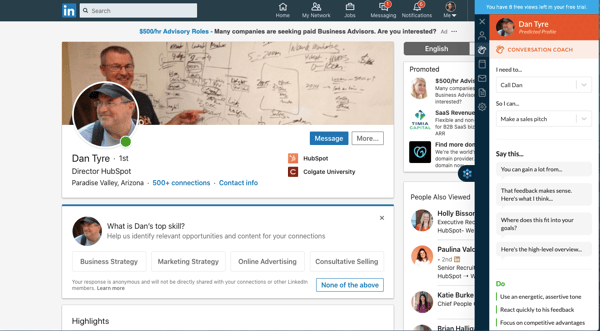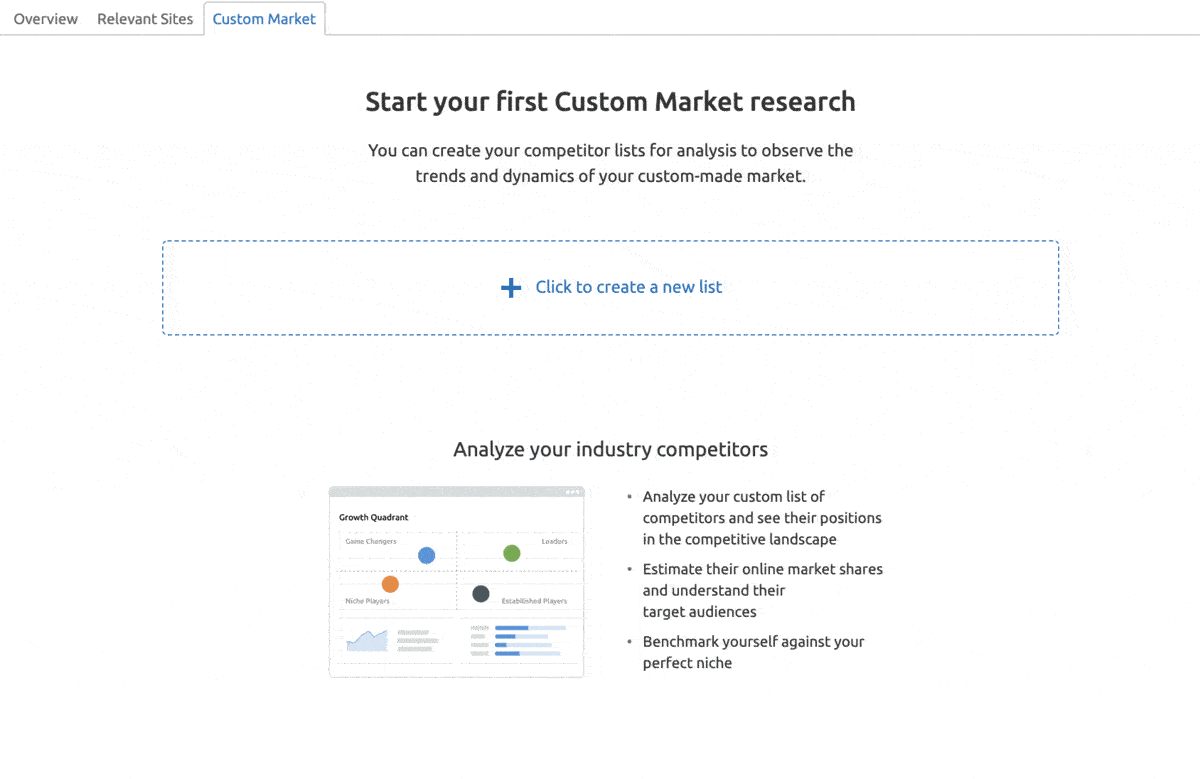How to Create Your Buyer Persona [live webinar transcript]

I'm so happy to share this transcript from an SEMrush webinar on Personas that I was fortunate to present. The host, Tristam Jarman, opened the door and I walked through into a wonderful world of friendly faces and great questions. I hope you enjoy. There's a lot a good intel in here.
 Tristam Jarman:
Tristam Jarman:
Hey, folks. We are live for another SEMrush webinar. It's the 12th of August 2020, and at the moment in the UK, we're having a heatwave and it is very warm. I hope it's warm wherever you are.
We always love to know how far the community spreads. I'd just like to introduce Randy Milanovic. Randy, I hope I've pronounced your name correctly, otherwise, this is a very embarrassing start. How are you doing today, Randy?
Randy Milanovic:
I'm doing great, thank you.
Tristam Jarman:
Nice. Randy is the CEO of Kayak Marketing. He and his company have helped over 550 organizations grow their business. For anyone who doesn't know, I'm Tristan Jarman. I'm the co-founder of Purple Smudge down here in sunny Brighton in the UK. But without further ado, Randy, would you like to intro what we're going to be covering today?
Randy Milanovic:
Sure. We're going to be doing buyer personas and how to create them and some tips and tricks about how to do them right.
Tristam Jarman:
Perfect. We really do have another worldwide audience joining in today, so I'm really excited to get this started. Randy, if you're happy, I think it's time to hand over to you and we can get this started.
Randy Milanovic:
Okay. First of all thanks for having me on, and hello, everybody. I'm so glad we all made it in today. Thank you, Tristam, for hosting this webinar.
Today, we'll be talking about buyer personas and that's some very exciting stuff. Now, we only have about an hour, so I'll get right to it. As Tristan said, I have had the pleasure of working with about 550 companies now to help them develop their buyer personas, improve their ‘smarketing’ results, and grow their companies. Yes, I said ‘smarketing’; after all, buyer personas are strongest when developed in collaboration with sales, marketing, and your operations teams. When everyone is aligned, it's ‘smarketing’.
Resources: [SEMrush webinar (audio issues on Randy's end)]
[Randy's re-recorded audio] [Presentation Deck] [Deck with Speaker Notes]
What Are Buyer Personas and Why Are They Useful?
Buyer personas are semi-fictional representations of the people you want to do business with. Buyer personas are your secret key to driving real business growth. They help you focus your efforts on qualified prospects, guide product development to meet the needs of your customers, and align efforts between your marketing and sales and operations teams.
Regardless of what stage your company is in, you can create insightful buyer personas or profiles of them that represent people you want to work with, along with their influencers. That's an interesting side of that, to understand who influences your personas, very important.
Content crafted to your buyer personas will help you attract highly qualified business leads - and customers - and it will filter out those less desirable visitors because they will see that your content is not for them. These types of leads are really good; as they're more likely to retain you over time.
When creating your buyer personas you'll want to consider a mix of demographics and psychographics, especially psychographics. The more you know about what excites, scares, annoys, or even angers them, the better. Because with that intel, you can craft content that connects with your prospects incredibly well.
Just to clarify... buyer personas are profiles of the people who work at your ideal client companies. Buyer personas are people, ideal clients are companies.
Before we dive into the buyer persona creation process, let's consider the impact that well-developed buyer personas can have on your business. Buyer personas help you to understand your customers much better.
No gut feelings required—personas are created from real information that represent a real person or persons. They can be data-driven; this is where SEMrush comes in. This makes it easier for you to tailor your content, messaging, product development, and services to meet the needs of your specific audience without getting lost in the weeds of trying to please everyone.
Here's an example stat from the SEMrush website... NetProspex has edited their website based on their buyer personas to create a customized visitor experience. The effort resulted in a 900% increase in site visit duration. That's incredible. Plus, an increase of 171% in marketing-generated revenue.
Tips for Creating a Strong Buyer Persona
The good news is that personas aren't that difficult to create. It's all about how you obtain your market research and data, and then share and present that information with your team.
For example, you may know your target buyers are a group of managers, but do you know what their specific needs and interests are?
Ask yourself what's the typical background of your ideal buyer? What's their life stage, are they just starting to have kids? Are they retiring? What are their biggest concerns? What are their secret desires, what do they fear? Do you see any commonalities when you look across your existing customers or even the desired customers you want?
The strongest buyer personas are based on market research, paired with insights that you can gather from real customers through surveys, interviews, net promoter scores, reviews, even informal chats with them. Depending on your business, you could have as few as one or two personas or you could have several.
If you're new to personas I recommend starting with two. You can always add additional personas over time, if needed. I personally like to create personas in pairs, because people don't often make decisions in a bubble. Being aware who influences your ideal buyer is smart and once you understand their relationship, you can work to create content that prompts engagement and dialogue – and interest in your products and services as a result.
I'm not talking about social media influencers here, or famous people. I'm talking about co-workers, spouses, and other close-in people they look up to or value the opinions of.
I also like to develop personas based on their role in the business. For example, let's imagine a persona who's in an executive role. Their decision-making focus is going to be quite different, for example, “does it result in market share or market growth”, from somebody in middle management who may be thinking, "will it achieve good results for the budget I've been assigned?" If you understand which one you're dealing with, you have insight into the type of conversation you might have with them.
To understand the role your prospect plays also helps you avoid the wrong conversation with them. I say ‘avoid’, because you could imagine if you're talking to a business leader and you're talking about workspace comforts, it's probably not going to resonate or be that meaningful to them and vice versa.
When working with organizations, there may be multiple personas. You know, a buying committee full of decision-makers, and each with their own focus. I'm curious Tristam, have you ever seen somebody in IT have the exact same priority as their colleague in finance?
Tristam Jarman:
I can answer that with an exact ‘no’. Finance people and accountants think in a certain methodical process and yeah certainly in the IT department we think in a different process. But to answer your question, no they don't think the same. They don't want necessarily the same outcomes or think that their customer profile is exactly the same.
Randy Milanovic:
Agreed. You could take a look at the IT person and know they're going to be very, very concerned about security, longevity, and stability because they don't want anything to go wrong; because it could mean their job. Then take a look at somebody in finance and they're making sure they're getting the best value for the money. Quite often they're looking at the lowest dollar or the biggest bang for the money, and the security thing versus the budget thing; they might not jibe at all.
Quite often what we'll do, is go to each one and find out what their needs are. What rules they follow, including their thoughts, fears, the whole thing. The best understanding possible so that we can create a tailored conversation to have with each of them.
A colleague of mine - Marty Tascona - talks about this as conversational fluency. Meaning adapting your conversation based on who you're talking to. Not to change the nature of your conversation, but to acknowledge that persona's role and needs. We can do that, of course, through content. Ultimately the idea is the more you know the better.
All right, so this is a really, really valuable stat. 93% of companies who exceed lead and revenue goals segment their database by buyer persona.
Segmentation; it is an absolutely fantastic way to organize your lead data. You're not just sending mass emails to everybody, you're effectively doing one-on-one or one on small groups so your message can be much more valuable and resonate with those individuals. Of course, with that you can get a much better response rate.
For example, you could send a persona in IT one letter, and send finance a different letter, instead the same letter to both. That pretty much makes sense, but it's amazing how many people don't think about that. Segmentation is a key aspect of understanding and communicating your persona.
Improving and Refining Buyer Personas
All right. Note that you can improve your buyer personas, too. I always want to start with what we already know and expand from there. What we already know is the information we have in our database on our existing clients. From that point, we can go further.
I'm not sure if anybody here is familiar with Dan Kennedy's, The Ultimate Sales Letter. The book is incredibly famous. My friend Joel Klettke of Business Casual Copywriting reminded me recently of the questions in Dan's 'The Ultimate Sales Letter', that I think are really important in developing personas. The following four questions in particular are asking really important in-depth questions.
- What keeps them awake at night, eyes staring up at the ceiling? How a promise to solve the problems might shake them by the collar and get them to act.
- What are they afraid of? You know, fear is a powerful motivator, we will do anything to distract ourselves from it or make it go away, including buying.
- Also, we want to ask, What they're angry about?, or perhaps who they're angry at? Perhaps it is government policy, the weather, anything that might impact their business or their daily life.
- The fourth one is to determine what their top three daily frustrations might be. These are the things that frustrate them enough that they'll pay to get rid of them. You'll want to think about this, of course, in the context of your business solutions. For example, somebody says they can't get anything done, and you provide project-scheduling software. Easy win.
When we dig into what makes them tick, and motivates our personas at an emotional level, that's really, really powerful intelligence.
The Importance of Leveraging Existing Customer Data
As I mentioned at the start, start by looking through your existing data. Look for trends around how your best leads, your customers, find, and consume your content. You might be looking at Google Analytics or Search Console. You might be looking at your CRM. You use a tool like SEMrush, or you might go into HubSpot; which presents exceptional information on individual visitors, and look for trends.
Tristam Jarman:
I’ve got my own company now, but I work with multiple companies at the moment that work with in-house agencies. I find it surprising, still, from yesteryear even to now the marketers, people that run companies, website owners; they're not even looking necessarily at Google Analytics data. Or maybe they're not aware that something as simple as Google Analytics data can uncover so much about, you know, the customers, what they're doing on-site.
I know there's the demographics section in Google Analytics and I'm sure someone would jump in here now into the comments and say, "That's not 100% accurate.". But what I always think is although that data isn't 100% accurate, it's more than not having any data, so you're making some form of a smarter decision.
Just out of curiosity, do you still find that working with people, that they're not necessarily utilizing just some of the basic data they have? Without you know using tools like SEMrush, HubSpot, and more sort of paid for, subscribed tools.
Randy Milanovic:
Yeah exactly. A lot of people are just guessing and a lot of times what they do is they project themselves into the personas. They go, “oh you know somebody like me would do this”, and they believe that that's going to be their persona. It's usually not.
What I find a lot of times is people will get a tool and they'll kind of set it and forget it and they don't go back and look at it. They don't realize when there's a hole, even with Google Analytics you'll see all of a sudden there's a drop off at a certain page. If you were just to look at the page it might find that you missed a link, to put a link in or something like that, because it's human error. Or an image that was oddly cropped or something on that page and so it turned people off.
It's so important to watch the data and see what's going on and know how people use your site and how people get to you. It really helps you not only qualify but also disqualify.
Two Common Buyer Behaviour Patterns and More Tips
There's two behaviour patterns that I see all the time. One is that an individual comes to a website and goes straight to contact. Maybe spend a brief moment on a service page, then hits “contact”, and either phones or fills out the contact form.
Another behaviour I see all the time is people come into a site, and they hit a hundred pages or more, and they may not hit contact at all, but they'll do a download.
One of them is somebody who's acting and wants to make contact/buy, and the other one is a researcher with little to no intention of acting/making contact. In fact, fully 95 percent of people that aren't making contact right now, are researching in preparation for making a contact or a purchase, or in prep before referring someone else. It's really important to pay attention to watch how both of these visitor types use your site. It's really important.
There's also a scenario if they spend little or no time on your product or service page before making contact. It's very likely that they just want to know what the price is. The phone call that you get from visitor that is not going to be highly qualified.
If that same individual visits the service page and then visits the about page, or your executive page and then visits the contact, it is entirely different. These people are visiting an about/executive pages because they're considering doing business with you. This is an indicator they are likely a high-quality lead.
All right, so we'll go through a couple more tips here. One of my favourites is qualifying questions. When we do forms, we like to start with a qualifying question. Now, if you could imagine, if you suspect or believe that your ideal buyers have a common, say, challenge, you can ask them a qualifying question about what their biggest challenge, right at the top of a contact form. Then watch for patterns in how they respond.
Or you could pre-build four or five options in a drop-down that you believe fit with your persona. Maybe one that doesn't. And see which ones they pick and see if you can discover patterns in how they respond. When you have that information, you can then further refine your personas to incorporate those insights.
For example, as a HubSpot partner, one of our core items is that we know we need to work with customers that have two or three internal team members in their marketing department. If they have fewer, chances are they're not going to have the budget to work with us. If they have a larger team, chances are they work in departments or siloed units where it is much more difficult to align and coordinate team members.
We might ask, "how many marketers do you have on your team?" A very simple question that almost everybody would answer. These types of questions don't only helps to qualify, but also to disqualify. If they answer 25 people, they're probably not going to be a perfect fit unless we can establish departmental/regional team leaders and affect internal polices and procedures.
One of the things that I like to encourage my clients to do, is take their marketing team and go straight to the sales team, ask them questions, and find out what's going on in the front line. Find out what insights that they have. What's a good client to them? What's a bad client to them? Bring in awareness around that.
An easy one is to interview customers and prospects to discover what they like or don't like, of course, about your product or even your industry. Maybe you're an accountant, and they come to you just because they have to, you know?
Okay. There are tools out there that really help us dig. Personality profiling...one tool that I've used is Crystal Knows. It's really an incredible tool, and it's full of different personality profiling tools that you can use, even for yourself. It's good to know 'you', too.

Say you're in LinkedIn and you go to somebody's profile. Crystal Knows tells you their personality profile and gives you insights on how to talk to them, or how to present to them, or how to ask them questions. Tristam, I'm curious to know if you've heard of Crystal Knows?
Tristam Jarman:
I personally have heard of Crystal Knows, and I've only briefly used it, it's something that I kind of want to use a little bit more. It seems quite an interesting tool. Little bit weird and creepy. But in terms of what it can do, it does sound pretty phenomenal. It's something I'm personally looking to sort of delve into a little bit more.
Listener question: Can You Create Internal Personas?
Just to take a slight side jump, you were talking a lot about building a customer persona, and we had a question from Marley, who asked, "can you create a buyer persona for internal stakeholders?"
From what you were saying, you know, find out what's keeping them up at night, you know, what are the good and bad things? So, yes, personally I think you can create a customer persona for, you know, for internal use within your company.
Randy Milanovic:
I think you could create one for your boss if you wanted to. ;) The idea is the more you get to know what they are like, the better your relationship can become.
Tristam Jarman:
Communication is what this all boils down to. It's the avoidance of spam; spamming them, or mass marketing. You're doing individual communications on a robust level.
Randy Milanovic:
I guess what we've learned today is, whether it's a buyer, customer, prospect, or partner persona, it tends to be deep. Dig, dig, dig: get that information. The information's out there. I think that this is probably what's overlooked the most. People just think of prospects and customers as targets or audiences or churn or whatever. They're not thinking of them as people.
Treating people as people changes the whole interaction. We start to have real conversations, not "buy my stuff" conversations. Those are failures.
Listener question: How Often Should You Revisit and Update Buyer Personas?
Tristam Jarman:
Yeah, awesome. Just quickly we've had a question coming from Hayden Jay. He's asking, "how often do you revisit a persona?" Because obviously habits change. This other question from Johan loops quite nicely. "Did you, or have you found any huge differences in personas pre-pandemic and now?"
The two questions are nicely linked there. You know, what should companies be doing now? Where it's like, oh, six months ago, or a year ago, this was our customer, our buyer, and now, actually, we might need to revisit it.
Randy Milanovic:
Yeah, that's an excellent idea. I would say anytime that something happens like COVID, or you change your product, or you notice something, you need to go back and review, refine, and make sure it's still accurate.
I'm watching behaviour almost day-to-day. I'm one of those guys who really watches trends, over a length of time. I want to see if I'm getting more interest one way, or more interest another way, or less interest. I want to know that and go back to my personas and I see if I have to tweak. If I tweak the persona, I'll go back through my content and optimize it again.
When we see an obvious trend, or if there's a big event that's happened. Perhaps we've changed our product line, or changed location. Then we need to revisit, for sure. Because it's likely we have a whole new message to communicate with our personas.
Buyer Persona Must-Haves
I have to share a little story with you guys. Okay, way back in the ‘90s, mid-’90s, I was working in ad agencies. I think computers were just coming out. I think we had a Mac SE. The little tiny one with a single floppy disk port.
But anyway, back in the ‘90s what we used to do with our personas at that time was take a cardboard cutout of the individual, given them a name, and we'd write the name across the chest. We would look at it, and we would write our creative of that individual; imagining or envisioning that person as a real human.

We weren't just marketing, we weren't just doing an ad – we were doing an ad for a person. Defining a persona today is the modern equivalent of that. Just don't make it, of yourself.
A couple of buyer personas must-haves. Of course, we have demographics, so we have things like age, sex, income, role, et cetera. But I like to spend more time digging in psychographics; those fears, desires, values, influences, needs, personality types.
Include wording in your profile around bigger challenges and their primary goals so you know ultimately what they need to achieve, and then you work to help them achieve that.
A reminder that buyer personas are people: ideal clients are companies.
Finally, we have a lot of resources. There are literally hundreds. But for starters, we have SEMrush's Market Explorer tool, which Tristan demonstrates in the video. Tools like Survey Monkey, the Make My Persona tool by HubSpot. Dan Kennedy's ultimate sales letter, my book The Art of Flowww as well as a really interesting article, titled “Twelve Questions Your Prospects Are Asking Whether They Know It Or Not”, that goes to the real psychology behind what motivates people to act or not act.
On the SEMrush blog, there is a How to Create Your Buyer Persona article, and there's a link in the article to a buyer persona template that you can download and use. It's fairly accessible.
I think on that note I want to thank you all for having me here today. I'm happy to stick around, take questions after Tristan completes the demo. If it's okay with you I'm going to stop sharing my screen.
3 Biggest Mistakes When Building a Buyer Persona
Tristam Jarman:
Yeah, awesome. Thank you very much, Randy. It's been a fantastic presentation. We've had a few audio issues, but I think though the general vibe message has got across. Just whilst I'm switching to my screen to do a quick demo Randy, what would you say three biggest mistakes in building a buyer persona are?
Randy Milanovic:
Not enough information. Not asking our customers, not talking to them. We're just guessing or just looking at them. We need to talk to people: that's the big one. I would say not going deep enough. Not digging enough. The third one would be that there is a reliance on demographics, not psychographics.
How SEMrush Can provide Useful Buyer Persona Data
Tristam Jarman:
I'm just going to jump into a quick tool that SEMrush has got live. If you're looking to understand a bit more about who your customers are, your audience, et cetera, there's a neat little tool inside SEMrush that if you have SEMrush and you open it up and you navigate to the Marketing Insights, and then Market Explorer.

I'm just going to show you an example of the New York Times here and what we can find out, really. What we've got here, is we've got what's known as the Growth Quadrant, which helps you to visualize the competitive landscape.
You've got the traffic volume, which represents the current audience size. The traffic growth, which reflects the pace at which researched competitors expand within your market. We've got Game Changers, you've got Leaders, you've Niche Players, and Established Players.
If you're using SEMrush and you didn't know this tool existed, I'd highly advise you jump in here and start having a look at this extra data that you've got. Then what we can do is actually scroll down into sort of the Share of Visits here.
If you jump into each of these search bars, it starts to bring up here more of the total traffic information which starts to help you break down more about your audience, but also your competitor's audience and start to understand that.
The section I really like is this section here. You can see your in-market audience, you know, what do your audience like to do online? Also, who is your audience? For the New York Times here 44 percent are female, 56 percent is a male audience. That's from July of this year. You know, if you're sitting there going, "well I didn't have any of this data before," you do now, and you can really start to see, you know, or break this down even further.
You may have had a conversation internally, and I’ve seen these conversations where, you know, a company will say, "Our client is 45-55 and it's mainly males.” Then when you actually start to dig into some of this more robust data, you can actually start to see what the true figure is, not what people think their perception of what their customer is.
I'm going to stop sharing my screen. Let's just open it back up to the table and see what questions we've got. We've got another question from Hayden.
Quickfire Q&A on Buyer Personas
Randy Milanovic:
Hayden asked about personas, the time to create personas, and really my feeling is if we start with the data we already have, we'd probably review it and write the persona in a few hours. After that, continuous revision and refinement for the lifetime of that persona, or that product, or that business. I think they never really end if you're paying attention.
There was another one that asked about a mistake, and that a big one would be building personas around your products and services versus the people.
I love behaviour-based personas. You know why we love behaviour-based personas—we only have maybe three. We have our decision-maker, we have our influencer, and then we have a referrer.
When we have those three, we can pretty well map any product or business service under one of those. If somebody has fifteen personas, they're probably doing it by product. Which I would say is, you know, they really better have it dialled in.
Tristam Jarman:
We're almost getting to the top of the hour. Randy, thank you very much for presenting today. It's been awesome. If you could just leave us with one or two takeaway points...what would your one or two takeaway points be from today?
Randy Milanovic:
Well, quite honestly, it's really getting to know your prospects and customers as human beings. When you develop your persona, base it on behaviour, not on products and services. Then you have the potential to create real, essentially one-to-one communications, even though you're doing it en masse. The second one is don't trust your gut; do the data, do the research.
Tristam Jarman:
Fantastic. How can people find you if they have any more questions, or want to find out more about this, this new journey that they might just be descending on with, you know, in their department or within their company?
Randy Milanovic:
Sure, of course, people could come back to this presentation. But I'm available online. Just type my name, Randy Milanovic on LinkedIn, on Facebook, and also I'm on X (Twitter) at @kayak360.
Tristam Jarman:
Perfect. So, I'm @TristamJarman on X (Twitter), so come and find me if you've got any more questions. But that's all the time we've got for today. Thank you very much. I've had an absolute blast.
Randy Milanovic:
Thank you, Tristan. It's great to be on.
Tristam Jarman:
See you later, guys. Bye for now.


